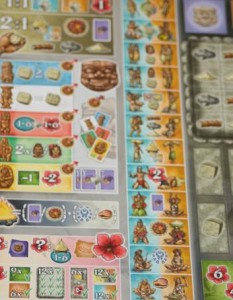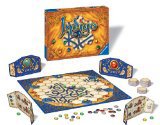Earlier in the year Ravensburger Games asked if I’d be willing to review a couple of games for them. I enjoyed Asara and Indigo so was happy to repeat the request by reviewing two more: Castles of Burgundy and Bora Bora
Castles of Burgundy
The basic idea of the game is to build large estates by placing hexagonal tiles on a board. Points are scored for numerous things including: acquiring animals, placing buildings and gaining knowledge. The limited supply of tiles on the central board encourages players to compete against each other to obtain the best ones, although the clever use of knowledge tiles ensures that every player may use a different strategy to win. Play is controlled by the roll of dice, but luck is minimised by collecting appropriate tiles and the most skillful player will almost always win.
Age range
Castles of Burgundy is for players aged over 12. The complexity of the rules mean that it isn’t a good starting point for strategy games, but if you are a serious gamer you’ll find a lot to enjoy.
Design
The game is beautifully designed, but it is let down by a few components. The central board and playing pieces are of a high quality, but the individual player boards are made from a stiff paper that is easily damaged. The box is also poorly designed. The game involves 5 different coloured hexagon tiles plus several other pieces and there are no separate places to put them in the box. This means they all get mixed up, leading to a long, fiddly set-up.
Number of Players: 2-4
The game is equally good with 2, 3 or 4 players. Each version requires a slightly different strategy to win, but this makes playing with differing numbers of people more interesting. I also liked the fact that numerous different playing boards are provided. This adds an additional layer of skill and extends the appeal of the game.
Overall
This is a well thought out game and is one we’ll be playing on a regular basis. I loved the complex strategy and the numerous paths to victory.
Recommended.

.
Bora Bora
Bora Bora works in a similar way to Castles of Burgundy, but is much more complex. Players must collect shells, workers and Gods in order to score as many points as possible, but there are so many different tiles and combinations that it is very difficult to learn. My husband and I spent about 10 hours learning how to play this game and still didn’t feel we really understood which strategies would be effective. We couldn’t go more than about 5 minutes without having to refer to the instruction book – it was a very frustrating experience. As an example of the number of different options here is a small selection of the game board:
Things might have been easier if we’d been taught by someone who knew the rules, but I still think this game is more complex than necessary.
Age range/Number of Players
The game is advertised for players over 12, but I think it is far more complex than that. It needs to have a minimum IQ quoted (about 140) and a minimum number of game hours under the belt (1000?). We felt that it was too complex for our friends and family to try (and we didn’t have 10 hours to spare to teach them!) so we were unable to try it with more than 2 players. This was a major drawback for the game – I prefer ones which are simple to learn, but difficult to master. Bora Bora might be an amazing game if you put in the effort to learn it, but you need a spare week, rather than just an evening or two.
Design
The game is well designed with helpful bags to separate all the components in the box. All the pieces are of reasonable quality, but some of them were small and fiddly.
Overall
This game was too complex for me. Recommended to serious gamers who have large blocks of time available to play.

.
Have you tried either of these games?










